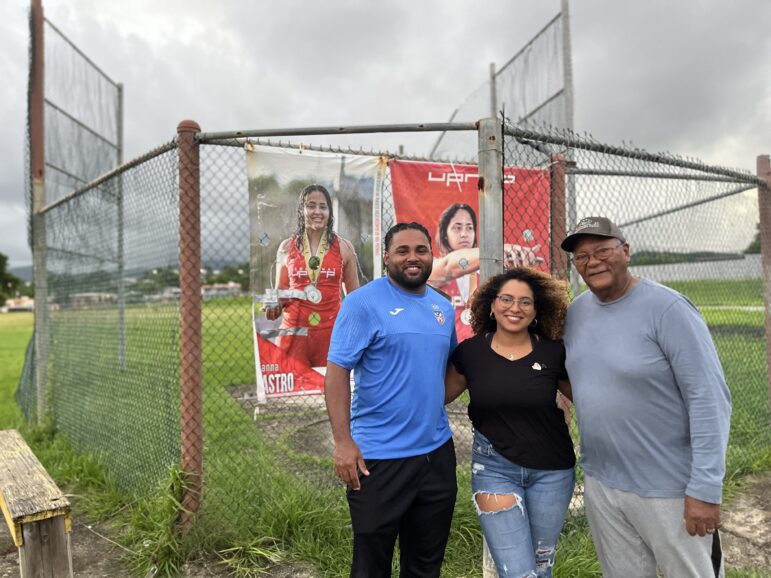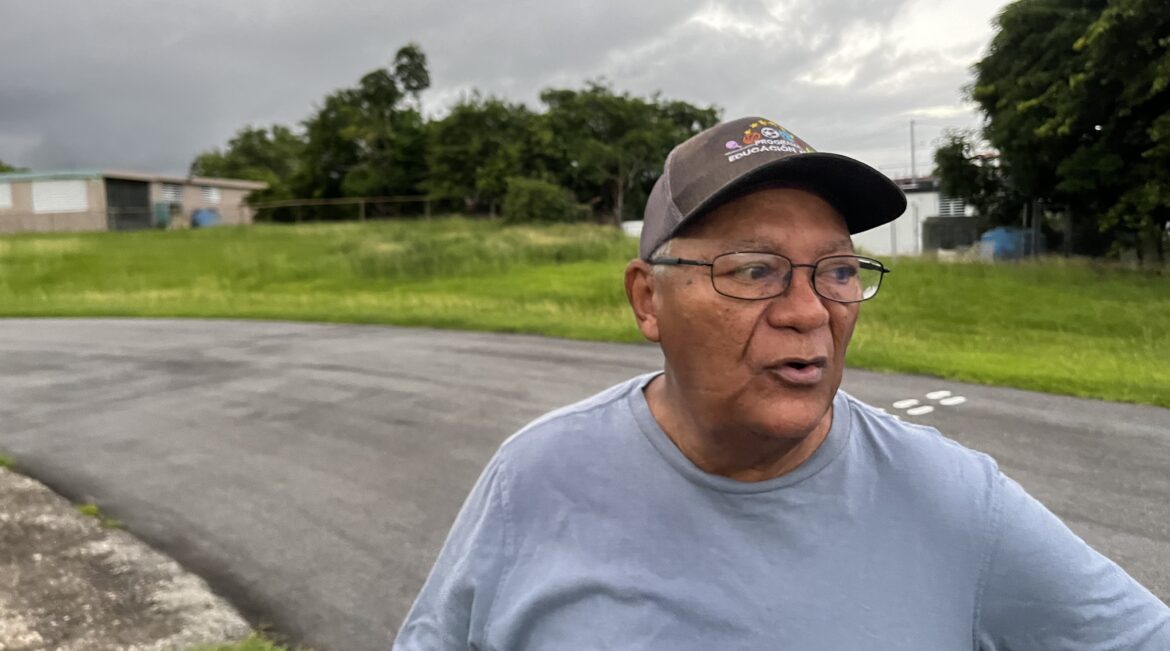“We didn’t have a cage [to throw the hammer and the discus],” says coach Alejandro Benítez. “The athletes and I, with the parents, built this cage.”
The cage is the structure that protects walkers and runners from any erratic hammer throws on the field of an athletic track.
It has been almost 30 years since Benítez built his “community work workshop.” The structure is still there, on the track of the Brisas del Mar neighborhood, in Luquillo, in the northeast coast.
“An engineer recently came and built a new cage next to it. They were warned the pipes had to measure four inches,” he says. “They made it with three-inch pipes. They used wires that they shouldn’t have used, and Hurricane Maria wiped out all that, and the one I built with my students is still here.”

Photo by José M. Encarnación Martínez | Center for Investigative Journalism
Benítez was an athlete who ran 400 meters. When he finished high school, he was immediately drafted into military service to fight in the Vietnam War for two years. That experience made him see sports and education as “something much deeper.” And since then, he has not charged a single cent in exchange for teaching how to throw the hammer, the shot put, or the discus.
“When I came back to Puerto Rico, I saw how the town was, how the island was… drugs began to be used. And in Sabana Abajo, in Carolina, where I lived, I began to recruit boys to jug on the roads. And when I started as a teacher in Luquillo, I did the same. I went with the long-distance and middle-distance runners. Then, I switched to pitching. I also trained in [hammer] throwing, long jump, high jump,” he recalls.
He said, “many thought they had to charge for this […] I saw sport as a tool to get kids out of the drug and alcohol environment.”
While speaking with the Center for Investigative Journalism (CPI, in Spanish), Benítez, who also served as a hammer throwing coach at the Río Piedras Campus of the University of Puerto Rico (UPR), is accompanied by Kyonis and Jerome Vega, siblings who, thanks to hammer throwing and school sports, opened doors that defined their professional futures. Both are public school alumni.
Kyonis is a marine biologist. She landed a sports scholarship at the UPR in Humacao, and Jerome, at the Metropolitan University, now the Cupey Campus of the Ana G. Méndez University. Jerome completed a bachelor’s degree in physical education. He won gold at the Central American and Caribbean Games in San Salvador this summer and is the national record holder for the hammer throw event. He broke the national record held by his father, Santos Vega, another pupil of Benítez and silver medalist at the 2002 San Salvador Central American Games.

Photo by José M. Encarnación Martínez | Center for Investigative Journalism
“We would get out of school and go to the track with dad. We started out playing around and what started as fun was transformed,” recalls Jerome, who finished 19th at the World Championships in Budapest, Hungary, in 2023, without being a full-time athlete.
From Kyonis’ perspective, school sports programs provided tools for the student to be directly involved.
“There were school competitions that began with a qualifying round in town, then they went to the regionals, after the regional qualification for the nationals, and from there they even traveled. That motivated many students from many schools, in disciplines that were not necessarily traditional, like [hammer] throwing, for example,” he says. “And something important is that the teachers always made it clear to us that it was a viable and real option to have sports scholarships to be able to pay for education at the university level.”
Jerome chose to go to the university where his dad was a coach. That way he was able to continue the work he started with Professor Benítez at the youth level. “It was the transition from having the potential to exploiting it, getting the best out of it, and once again paying for the education. I was fortunate to have a scholarship in which I didn’t need to work. It paid for my room and board, my studies, it paid for my books, and a monthly stipend.” This allowed him to focus on studying and practicing the sport.
Unlike her brother’s experience, the Humacao UPR could not offer Kyonis room and board and such a generous stipend. She had to work, study, and play sports at the same time. She was never able to live on campus. She traveled from Luquillo to Humacao – a 35 minute drive – every weekday, and then returned to train in Luquillo. The time came when she had to decide to prioritize her studies. Even with these difficulties, their situation was better than that faced by athletes in the UPR system since 2018, when the reduction in scholarships and a 50% cut to the tuition exemptions for athletes came into effect as part of the austerity measures imposed by the Fiscal Control Board.
“We had an agreement: I trained in Luquillo, but they let me represent the University of Puerto Rico in Humacao. But the cost of gasoline and the trip were very high. Sometimes I had to choose between getting gas, paying the toll, or eating. But I could handle it. My family was also crucial in that. Today I have a career thanks to sport,” says Kyonis.
Before getting his gold medal at the Central American level and becoming the first Puerto Rican to record a mark over 70 meters in the hammer throw, Jerome barely received enough funding to train full time.
“There was always a message [from the Athletics Federation or the Olympic Committee], but sometimes the message did not materialize. We had ideas, training camps in places with greater exposure, in the sense of countries that won world champions, Olympic champions. But it never materialized. Before the Central American Games [2023], I started getting help from the Olympic Committee. After I won in the Central American Games, the assistance increased. So, we’re improving in that sense,” the athlete acknowledges.
Training in the mornings, working during the day, and then training again in the afternoons is the equation of sacrificial success. “So, after all that, set aside a little time to be a husband, to be a dad,” this young athlete adds.
False sports start?
For the past 25 years, Cuban national Ubaldo Duany has experienced first-hand the development of the sports culture at Puerto Rico on multiple levels. His perspective is broad, both locally and internationally. He was a long jump athlete and trained as an athletics coach at the Universidad de Ciencias de la Cultura Física y el Deporte in Havana, Cuba.
Duany trained the two-time triple jump world champion and two-time Olympic medalist (gold and silver), Colombian Caterine Ibargüen, and trains Alysbeth Félix, the first Puerto Rican to win a Pan American medal in athletics, when she won silver in Santiago 2023, in Chile.
“The first thing is to pay attention to their education,” says Duany when asked about the keys to developing an elite athlete. “And that educational development begins in primary [elementary school]. When one relates it to a pyramid, that is the foundation of sports training, which begins in the students’ primary education,” says the coach, who has a privileged point of view having been immersed in two completely different sports systems: that of Cuba and that of Puerto Rico.
He has seen up close the disconnection between school sports, universities and then the impact that these gaps have at the highest competitive level in Puerto Rico. During his years in Puerto Rico, Duany worked as a coach at the Universidad del Turabo, and later with the Universidad Metropolitana of the Ana G. Méndez University System.
“Puerto Rico has a different type of development. The foundation of sports training here is in the clubs and the clubs are individual or private entities that work separately. There’s no monitoring like other countries have, with a methodologist to measure the process or where we’re going in that initial part [the schools], which means that there are very good results in lower categories and later they disappear in the high performance category, in the elite category,” explains Duany.
He speaks specifically about his experience with Puerto Rican athletics and the private system in which he worked, “but that extends to each of the sports,” he says. “Because the other link in the chain is the universities. And universities don’t necessarily respond to federations either because they’re private entities that respond to their own interests. So, if the universities don’t recruit the best methodological technical personnel to work with those people coming from the minor category and entering the university category and unable to develop them beyond the four years that they are in those universities, then results are being lost. And talents are disappearing. It becomes a cemetery of talent.”
For Duany, this doesn’t mean that these athletes don’t have the conditions to reach a high-performance level. The problem is that, although there are athletes who overcome the disconnection between school, federations, and universities, many do so at the cost of disproportionate sacrifice.
“Sometimes results are demanded [from national sports structures] that the athlete, by working and studying at the same time, cannot prepare full time as in other countries. It becomes much more difficult,” regretted the university coach.
Alysbeth Félix, who participates in the heptathlon and long jump, was trained in the private system, but she is an example of what Duany points out. “She must be here in one of the training sessions at four in the morning to later go to work and then come back to train in the evening. And that’s detrimental to sports performance. If Alysbeth had had much more time, much more support throughout her career, we would have been one step higher,” he said.
In September of last year, the Department of Education and the Department of Sports and Recreation signed a collaboration agreement to “improve and expand sports and educational programming.” However, the agreement expires next June without the results of that agreement having been seen. As of press time, neither agency spoke to the CPI about the scope of this collaboration.



